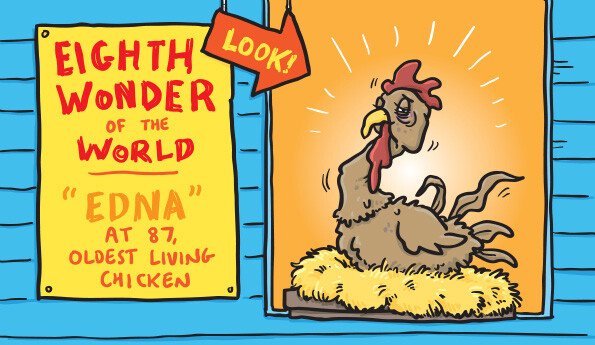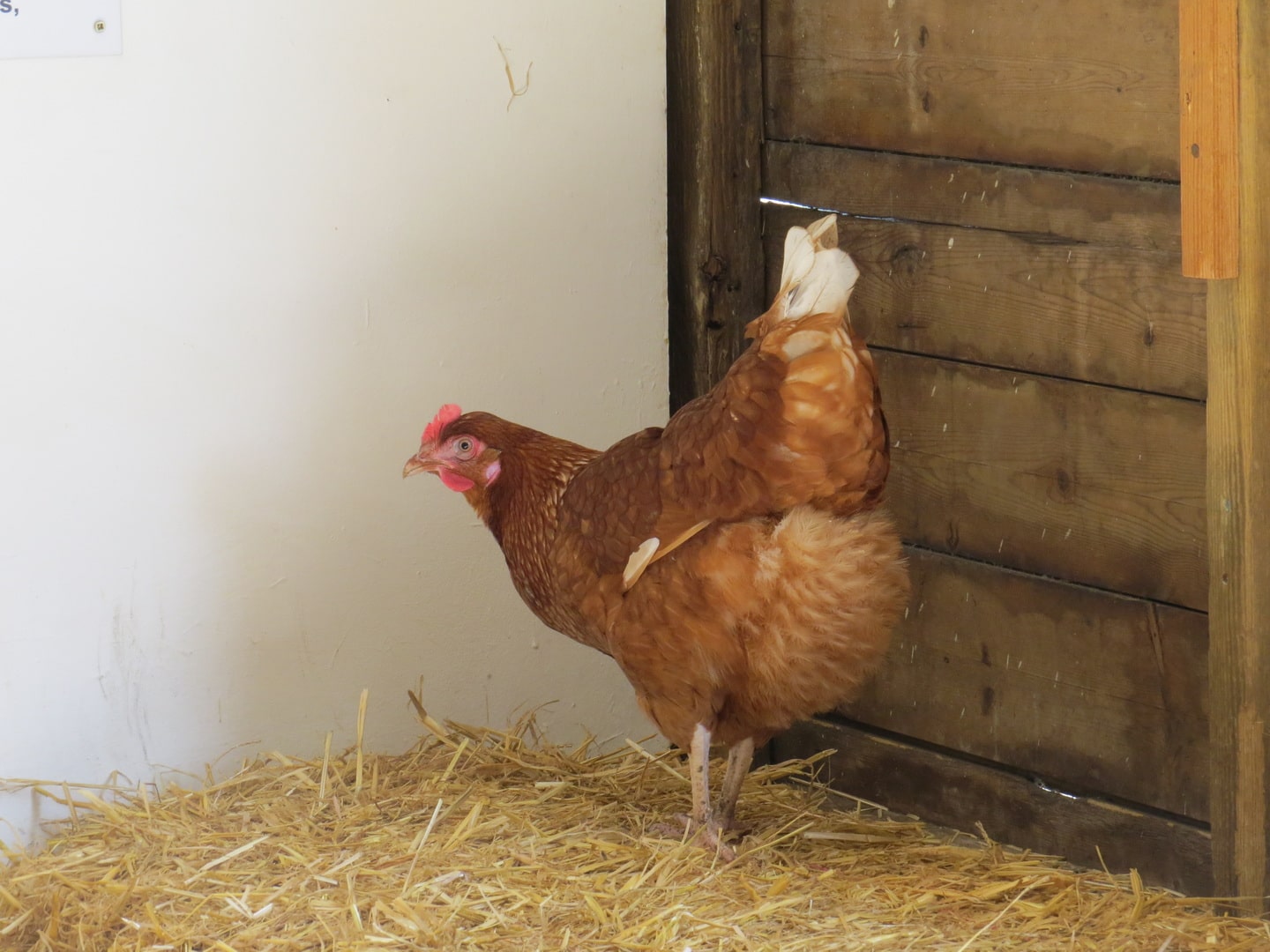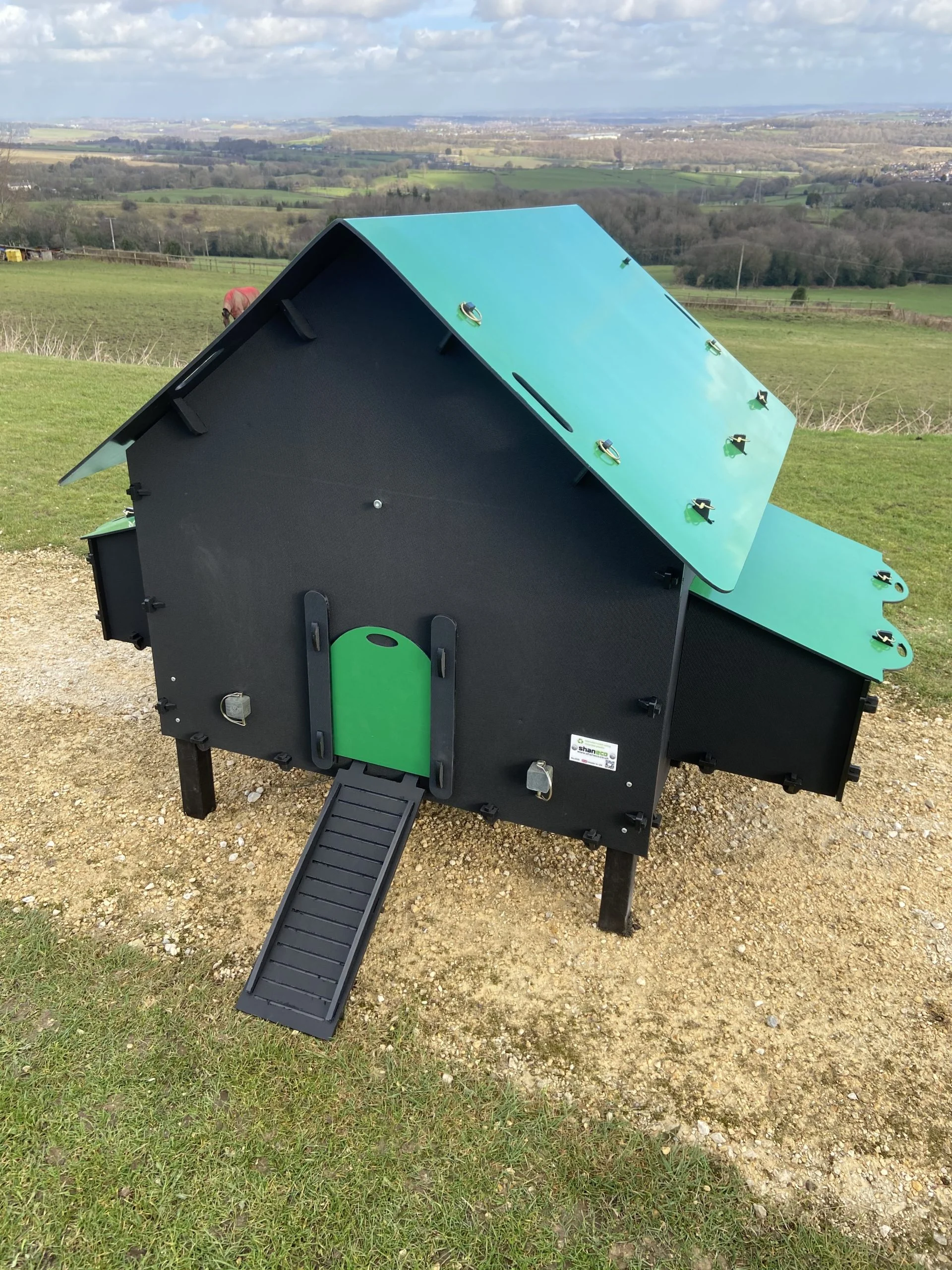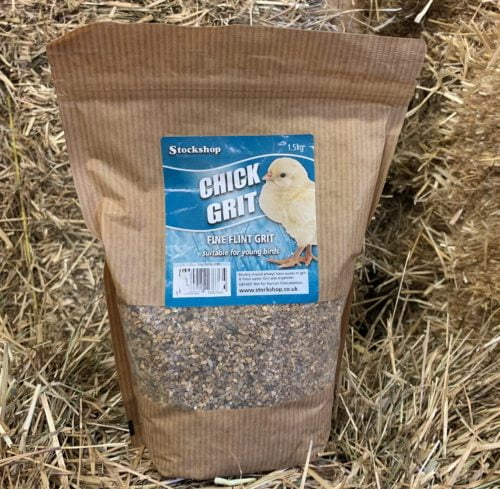First
Things First

Getting
Started
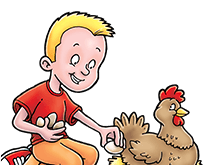
Food For
Your Chickens

Choosing
Your Girls
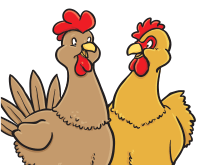
What Do I
Do When I Get
The Girls Home?
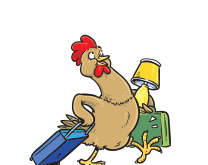
Common
Health
Problems
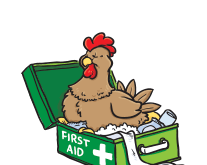
Introduction
My knowledge of chickens and chicken-keeping has been self-taught and is a result of breeding, raising, and selling literally thousands of girls over the years. We pride ourselves on our after-sales service here at Longdown, and I have always been delighted to assist our many poultry customers with any questions or worries they may have about their chickens.
Many of the same concerns seem to come up time and again, so I decided to join the 21st century and write a regular e-newsletter (click the link below to sign up for your copy) and create a special chicken-keeping website to dispense sensible, down-to-earth advice based on many years of poultry keeping.
I hope you enjoy my light-hearted guide and the wonderful cartoon illustrations provided by Simon Chadwick.
CHICKENS FOR SALE
We will be regularly updating and increasing our stock lines, so check out our CHICKENS FOR SALE page.
CHICKEN HOUSING
We also supply sustainable chicken housing which is robust and practical. Your chickens will be snug, safe, clean and warm in a Shaneco coop. Click here for more information.
You can visit our Chicken Shack at Longdown Activity Farm to purchase chickens, housing, feed, bedding, and equipment that all poultry-keepers should keep in their store cupboards. If you are a first-time chicken keeper, take a look at Farmer Bryan’s Poultry Pack which includes everything you’ll need, packed and priced for an easy one-off purchase. Click here for more information.
An important note from Farmer Bryan:
Whilst I have many years of practical experience looking after chickens, I am not a vet. If you have any serious health concerns about your chickens, consult your local veterinary service.
Sign-up for Farmer Bryan’s Poultry Email Newsletter Here
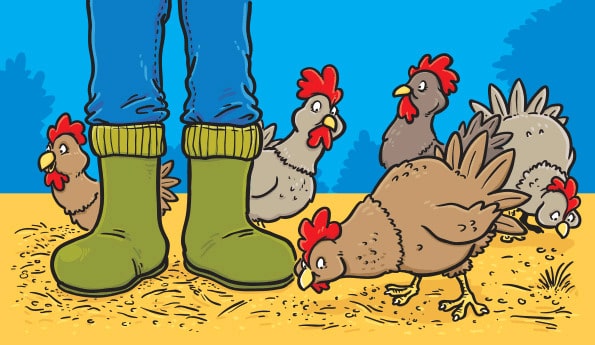
First Things First
The Jungle Fowl has been around for centuries and literally millions and millions have been reared domestically either for egg production (35 million or so in the UK although I have not counted them recently) or for meat to feed the masses.
Keeping Chickens as Pets
This information is aimed at a very small percentage of people who wish to keep a few chickens in their garden as pets and to be part of the family, to experience the real difference of eating really fresh eggs compared with those that have been produced in an unnatural environment.
The number of small-scale poultry keepers is expanding drastically. There are literally thousands of books and websites which will give you endless information on how to look after your girls, most of which are extremely informative and useful. The views and comments on the following pages are my personal experiences of looking after poultry. I am not claiming to be an expert or a veterinary surgeon, just a farmer who has kept chickens all his life (which is quite a few years now).
Most of the information available at present is based on traditional breeds of poultry. Personally I have kept the hybrids, which have been bred solely for egg production so their dietary requirements and husbandry needs differ from those of their old-fashioned traditional cousins.
Are chickens really the pet we need?
Let’s use the checklist above to make sure you are ready to keep chickens as pets:

Do you Have the Space to Keep Chickens?
If you are looking for a pet to come into the house, forget it, you will not house-train a chicken. They will require a purpose-built house (coop) in the garden. Each bird requires a minimum of 25cm sq. per bird as a sleeping area and, in an ideal world, a total of 3m sq. of exercise area for each bird.
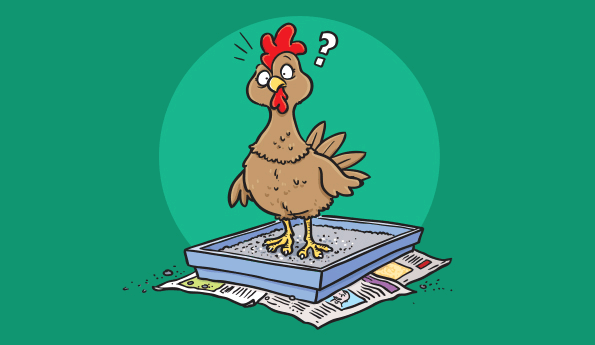
Are You Legally Allowed to Keep Chickens?
Some local authorities do not allow any form of livestock to be kept. It may be worth contacting your local Environmental Health office and, whilst doing this research, check the deeds to your property as well. If you decide to keep more than 50 poultry birds of any species you will be required to go on the Poultry Register.
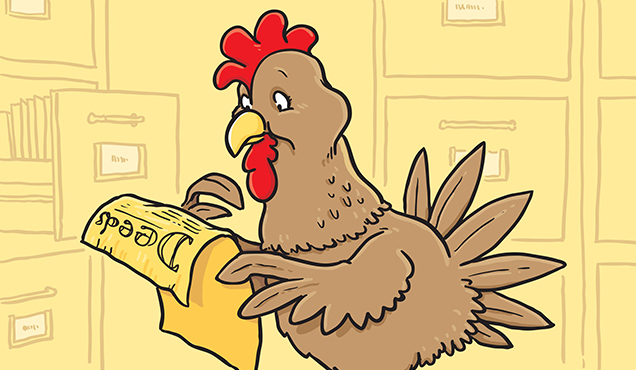
Have you Discussed Keeping Chickens with your Neighbours?
It will be the neighbours who kick up a stink first if they do not like the idea of having chickens as neighbours. They might find any reason to complain to the local authorities, and some will create stories about how noisy they are or about the smell they produce or how much damage the escaping girls have done to their garden. But, in most cases, they will enjoy having clucking neighbours and will be kept happy with a supply of surplus eggs.

Are you going to be a Responsible Chicken Keeper?
The girls will need to be looked after 7 days a week; they will depend entirely on you for their daily needs. Yes, of course they will scratch about and find a small proportion of their daily dietary needs in their run, but the most important thing is that they are checked on a regular basis: early morning visits to let them out into the run or garden, topping up food and water, a quick health check, cleaning out the house on a regular basis, capturing any escaping chickens and – most rewarding – harvesting the freshly laid eggs. Again, as the sun goes down, you will need to make a quick check that all the girls are in bed and securely locked away.
Of course you may spend hours just sat watching them scratching around during the day, but if you are planning holidays or just a night out you will need to have someone available to take on these duties (payment in eggs is the norm).

Is anyone in the Family Allergic to Feathers?
There seems to be a growing number of children and adults who suffer from various allergies so it would be an advantage to identify if this is going to be a problem before getting the chickens home. A visit to a local petting farm or to friends who keep poultry would be highly recommended, as discovering a problem after you have your own chickens could mean you have problems rehoming them, as most poultry suppliers are unable to take back poultry due to the high risk of cross contamination.
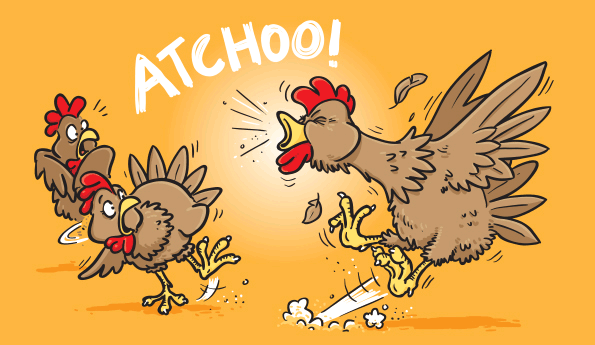
Do you really want them on your Manicured Garden?
A single chicken will (not may) destroy a well-manicured garden in minutes – just ask Dawn, my wife! If you love your garden, simply keep the chickens off it. You will not be able to train them to scratch around the edges, they will quickly go to the newest plants and seedlings and hurl them across the lawn and path and, as you shout at them, they will find more to destroy and happily cluck at you as you do a war dance at the side trying to persuade them to leave. If this is not bad enough just imagine what damage they could do to your neighbour’s garden. If they manage to find a gap in the fence, in a matter of a few minutes a beautiful, well-tended garden could turn into a resemblance of Twickenham rugby ground after a match on a very wet day. However, if you have a vegetable patch a small group of laying chickens will harrow the ground extremely well in the autumn as they search for any remaining greenery and juicy insects.
It is always best to keep chickens off play areas and grassland where children are likely to play as their droppings can contain viruses, and their poo makes a sticky mess on the carpet!
Assuming that you have not been put off keeping chickens, the next step is to look at what is required before you bring the girls home.
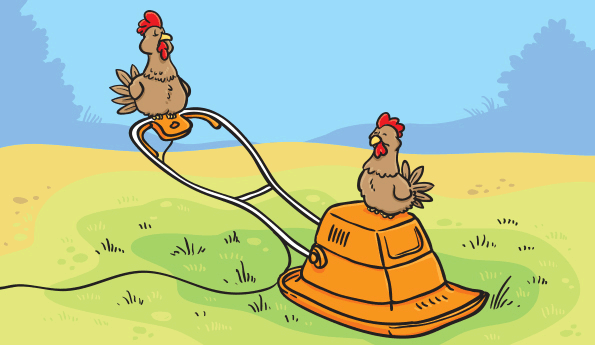
Cheap Eggs?
Cheap Eggs?
If you are thinking of keeping chickens to obtain cheap eggs, think again: the cost of setting up to keep chickens can be very expensive. However, the satisfaction of producing a regular supply of fresh eggs and creating a hobby that can give the entire family hours of entertainment and education are factors that need to be included in any calculations. Also it’s a great present idea for the family that has everything!
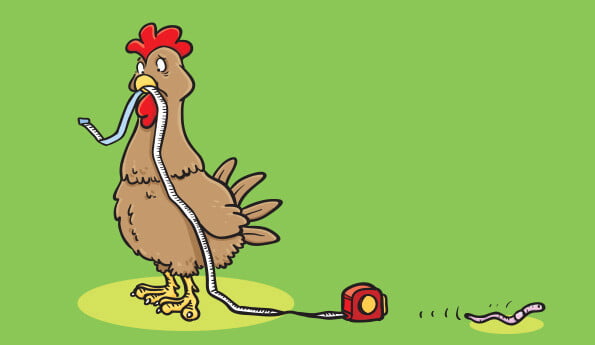
Housing
The Chicken House
Without doubt this can be the most expensive part of setting up, but before you scan through the eBay special offers have a look around your own garden. Do you have a shed that is not being fully used, is there a child’s play house that is only used to harbour old toys and garden furniture that hasn’t seen the light of day for the past few years? I have even seen plastic compost bins being converted into useful coops, but be careful if you are tempted to use a disused rabbit hutch as these do not normally allow enough head room for the chickens.
Maybe you have someone in the family who enjoys carpentry, although unless you can source your materials from a very cheap supplier, you may find it works out more expensive this way.
If all else fails then the internet is an ideal way of sourcing the coop, with many sites showing detailed photos of their “improved designs”. I certainly would not be able to tell you which ones are the best, but I would suggest that you get what you pay for.
A few things that I would consider before parting with my hard-earned money are:
The house should be large enough to home the number of birds that you intend to keep; it would even be advisable to choose a larger house to accommodate a few more girls later. An average hybrid chicken requires a minimum 25cm sq. of floor space. It is worth checking the full dimensions when buying a coop as for some reason the recommended bird capacity is not particularly accurate on many of the imported coops.
If you do not want your girls to wreck the garden, then a coop with a run attached would cover the extra cost of replanting the flowerbed. If you allow 2m sq. per bird this will keep all the animal welfare people happy, but more importantly your girls will be contented. A shade on top of the run to protect them from the elements will be appreciated by the girls, but please do not cover it completely as they do enjoy a little sunbathing at times.
Depending on your physique, do you require a house that you can walk into to clean out or are you going to send in the kids to crawl through the small entrance? It’s worth making sure the doors have strong hinges and a secure fastener, as there are some out there that the fox will easily open.
Nest boxes are best attached to the outside of the house, for ease of egg collecting and because they tend to keep cleaner. One box per 4 chickens is adequate, at least 45cm off the ground in an ideal world.
Plastic houses are much easier to clean and reduce the risk of little parasites like the dreaded red mite as there are no cracks or crevasses for them to hide in, however it is extremely important that these are sited away from direct sunlight, to avoid the possibility of overheated chickens.
Please do not buy a house with a felt top roof. If you do you will be providing a breeding place for thousands and thousands of red mites and even lice; they simply breed and breed under the warm conditions and no one can reach them as they are snuggly under the felt, and each night they crawl down and feed off the chickens and stagger back to their cosy environment and produce even more and within a few weeks you will have a major problem with your girls becoming lethargic and very poorly. Watch out when buying your coop online that the advert states what sort of roof materials are used; normally, if it’s not mentioned, then you will most likely find it is felt, because this is the cheapest material to use.
At Longdown Activity Farm we sell Shanco coops which are made from recycled plastic. Manufactured in the UK, they are robust and practical, and easy to clean. We have a selection of these on display, with chickens in, to allow our customers to see how viable they are. Click here for more information.
To protect your chickens from predators, weld mesh should be used in preference to chicken wire, as you will find the crafty fox will eventually get his teeth through the thin chicken wire to snatch his prey.
If there is a run attached to the coop, make sure the door is large enough for you to persuade the reluctant girls to go into the house, and that you can fit into the gap to retrieve the water container and feed bowl, otherwise you may be giving the neighbours something to laugh at as they watch you squeezing through the gaps.
If you are looking at moveable houses and runs, it’s worth checking that there are secure handles to allow you to move them, otherwise you will soon be damaging the framework.
Building your own Chicken Coop
If you are building your own style of house or coop these details are important:
Ventilation is vital. Vents should be at the top of the house to avoid draughts and to allow the strong ammonia to escape. Ideally these should be adjustable to control air flow.
Floor space: 25cm sq. minimum per bird (hybrids).
Outside run: 2m sq. per bird. This should be covered to prevent escapees and to keep wild birds out.
Perches: 5cm by 5cm timbers rounded off on edges, 25cm off ground, allow 18cm per bird – make them removable for ease of cleaning – if more than 1 perch, keep them 25cm apart.
Pop hole door: 35cm high by 40cm wide.
Nest boxes: allow one box per 4 chicken, 30cm by 30cm.
Distance off floor: 45cm.
Nest boxes should be kept as dark as possible to avoid egg pecking; hanging a dark cloth with a slit in it in front normally provides this.
Best not to site the coop in direct sunlight and consider drainage from the run.
Please do not use felt on the roof!
It is always worth setting up the coop and fencing before bringing the girls home just in case it takes longer than you anticipated.

Fencing
Free Range Chickens?
If your hens are going to be allowed to free range, to protect your garden and the neighbour’s, it’s important that the perimeter fence is secure, mainly to stop predators from entering and also to prevent the girls from invading the well-manicured garden on the other side of the fence. Fencing panels are ideal for this or fine meshed wire. Watch out for the clever ones who, despite having their wings clipped, will still be able to somersault over a 1m fence. Gates and doors will also require mesh of some sort. It’s nothing personal but these feathered creatures are very inquisitive and will spend hours trying to find out what is on the other side of the fence.

What other equipment is needed?
Other Equipment
As long as you provide a safe house to protect your girls from predators and provide food and water that is easily accessible then there is not too much more that you require initially. As you get to know your chickens you will find lots of things to spend your money on if you wish to spoil them, no different than children!
Feed containers come in different shapes and sizes made from plastic or galvanised tin. Really the choice is yours, depending on the depth of your pocket and your long-term intentions.
When deciding on which size to purchase it would be advisable that a full container should hold enough feed for all your hens for at least 3 days. Each hybrid chicken will eat approximately 150 grams per day. To avoid wastage, the feeder should have an anti-scratch insert around the base. Do not be tempted to use a bowl or biscuit tin as you will find that the girls will use this as a dust bath and have great delight in flicking all the Layers pellets across their run, until the last grain has disappeared into the dust! A weather-proof cover on top of the feeder is a good investment as this will allow you to place it in the outside run.
Water containers are probably more important than the food containers. Chickens simply cannot digest their feed without water, therefore it is vital that they have a supply of clean water close to the food station. Again, 3 days’ supply should be available; an average hybrid will drink 450ml per day, however as this is where most bacteria and viruses will start, I strongly recommend that fresh water is provided daily and the drinker is cleaned on a regular basis. If you provide water in an open bowl the girls will have fun scratching the dirt into this and within minutes it will resemble a pig’s mud bath. Both feeder and drinker ideally should be 15cm-20cm off the ground to reduce the risk of contamination, either by them hanging from a chain or putting them on top of blocks. There is no need to put weather-proof covers on the drinkers. Medication and tonics are normally given through the water, therefore it will help if there are quantity markers embedded on the side.

Inside the coop
Inside the Coop
The type of bedding used inside the house is a personal choice. I enjoy watching the chickens scratch about in layers of straw; they get a lot of satisfaction in spreading it around the house and searching for grain and insects, but the disadvantage of this is that they also can take it out into the run, which creates a soggy mess on a wet day. I have a large field where I can spread the end product but if you have a small garden, it will require a good compost heap to store it in.
Wood shavings on the floor and barley straw in the nest box make an ideal compromise during the summer months, then perhaps put straw on the floor during the colder months to help keep the girls warm and active. There any many varying opinions as to using hay or straw in the nest box. I have experienced some major lice problems when using hay, as this soon goes mouldy during wet periods, which then acts as an ideal breeding zone for the lice to expand in numbers. Also the girls tend to eat the hay, creating a risk of compacted crop. Barley straw is softer than wheat and oat varieties. If you purchase your straw in sealed plastic bags this will reduce the risk of bringing in red mite.
Wood shavings purchased in the larger bags are a better economical buy, but please remember that all bedding must be stored in a dry place.
Shredded paper can be used both on the floor and in the nest box, but besides having paper flying in all directions, it can get wrapped around the girls’ legs and feet, causing them to panic.
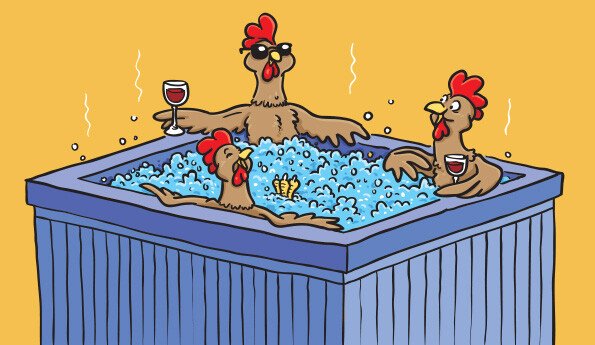
Cleaning Materials
Cleaning Materials
A strong shovel, a paint scrapper, a hand brush, a supply of strong plastic bags, a container of Poultry Shield and lots of elbow grease is all that is required to keep your girls clean and healthy. Depending on your coop, it is best to pick up the droppings under the perches daily and give the whole house a clean out once a week. Make sure that the soiled waste is moved well away from the chicken area and preferably somewhere that they do not have access to, otherwise all the little creepy crawlies that you have just moved out will be heading back to the warmer habitat. If there is a problem in the house with red mite or lice it’s best to clean them out on a more regular basis.
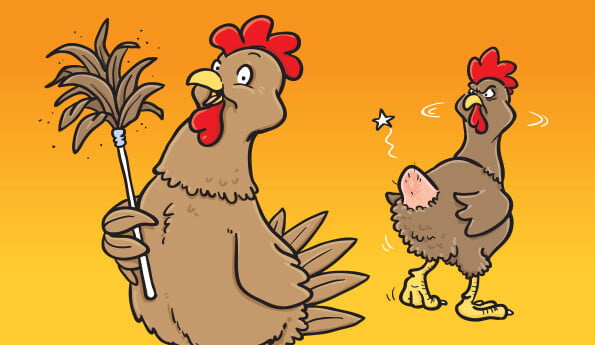
First aid kit and health box for chickens
Chicken Health & First Aid
As with all livestock it’s best to be prepared and a box with a few essentials could save a trip to the local veterinary surgeon later. As with children, good housekeeping can save many problems. This list of goodies will put you in good stead to prevent problems and to deal with any minor ailments:
1 litre Poultry Shield – for use in keeping the house clean and free of little bugs
1kg Diatom – for spreading in the house to prevent a build-up of red mite
250ml Poultry Tonic – to add to their water when the girls go into a moult or are stressed for any reason
1 can antiseptic spray for wounds
1 small pot of Vaseline (or Diprobase) for infected areas or feather loss, ideal for scaly legs and rubbing onto the combs during frosty weather to prevent frostbite
Cotton wool – to clear weepy eyes and runny nostrils
Spare egg box to carry all the eggs back into the kitchen

A Regular Supply of Eggs?
A Regular Supply of Eggs?
If you are looking for a regular supply of eggs from your chickens it is important that you feed them well. Hybrid chickens are simply egg-making machines; they have been bred to produce good-sized eggs as cheaply as possible, that is why they are smaller framed than their predecessors. These girls will produce a 65 gram egg each day after consuming just 125 grams of feed. Well, that’s what happens in the commercial world.
With your chickens having more exercise they may burn off more energy and will fill themselves up with lots of juicy insects and the best flowers from the garden. The most important part of their daily diet, without doubt, is Layers Pellets or Layers meal. All large commercial brands are suitable for the hybrids as long as they contain a minimum of 16% protein. If you wish to pay more for their food then there are some very good organic feeds on the market, however I have found that sometimes these do not contain enough digestible proteins for during the winter months, which sometimes prevents the girls continuing to lay throughout the winter.
It’s great fun giving the girls scraps and tit-bits but please be careful not to spoil them too much otherwise they will simply stop laying and you will have to pop down to the supermarket and purchase some less fresh eggs! Scraps should not be fed until the afternoon; in theory they should have eaten 80% of their daily requirement by midday and hopefully this should provide enough to produce a tasty egg.
No matter how they look at you with pleading eyes please do not feed your chickens any meat or kitchen waste (this is against the law) as there is a risk of contaminating your girls with various diseases and viruses – well, that’s the official status; any crops grown in your own garden are fine.
Of course your girls love mixed corn as much as children love chocolate, but it can be extremely harmful if over fed. Wheat and barley contain only 10% available protein but will soon turn your trim girls into dumplings, and fat chickens are not very productive either. You will soon find a drop in egg production if overfed. Another problem is that the hybrid chickens have a much smaller digestive system than their traditional bred cousins and often too much grain will lead to compacted crop. If you really have to give them some corn, just a small handful in the afternoon would be acceptable.
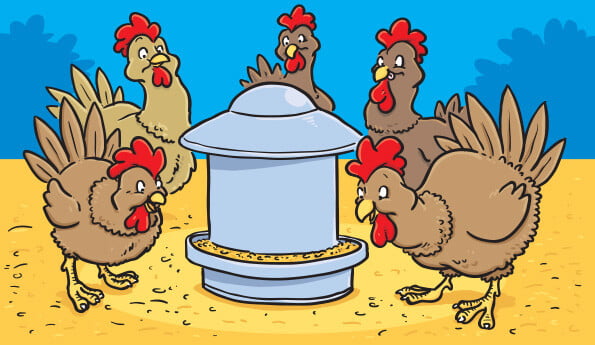
What plants are poisonous to chickens?
Poisonous Plants
In general a well-fed chicken will not consume poisonous plants as most have a very bitter taste, however there are a few plants that I would remove from the garden to be on the safe side. These would include:
Rhubarb
Young potato sprouts and leaves
Irises
Ivy – mainly young shoots
Privet
These are the ones that I have experienced causing a problem, however if you keep your chickens well fed with Layers pellets it will be just bad luck if they find a poisonous plant in your garden. I am more concerned about slug pellets, nitrates and chemicals used on lawns, and rodent bait that some poultry keepers scatter around; these are more palatable for the inquisitive girls and cause problems quickly.
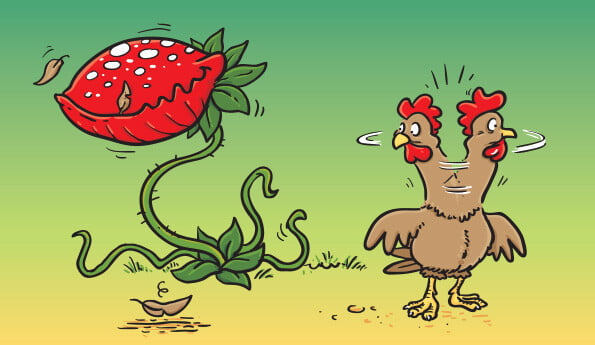
Special Treats
Special Treats
Like any pet we do like to spoil them at times with special treats and it’s fun watching their actions as they perform whilst eating them. Each bird has its particular favourites and it is part of the enjoyment in experimenting with different flavours. This is a shortlist of special treats, some of which I would recommend while others I would avoid.
The healthy list:
Bananas: A good potassium source, but 1 banana minus the skin between 3 chickens once a week, otherwise you could cause an imbalance in their potassium levels.
Soft fruits: Ideal source of vitamins and it’s great fun watching the girls running off with a strawberry or gooseberry in their beak, however too much and they will be runny from the tail end.
Greens: All greens contain many minerals and vitamins. A cabbage tied up in the run will give endless hours of entertainment and help reduce boredom. Green potato skins and shoots can be toxic and are best avoided. Do not leave surplus on the floor of the chicken run otherwise this will attract rodents and wild birds.
Dairy products: Yoghurt and milk mixed with porridge will help your girls get through very cold spells and aid quicker regrowth after a moult, but please be aware that all poultry struggle to digest dairy products so little and often is the best policy. Plain yoghurt would contain less sugar and therefore would be more beneficial. If you are having problems with soft shelled-eggs, whole milk will help increase availability of calcium in their digestive system. Mixing dairy products with Layers pellets or mash is ideal but please make sure that they have fresh every day, otherwise you will create a bacteria build-up.
Rice and pasta: If you want to get into the chickens’ good books then boil up some rice or pasta and watch your girls dance as they squabble to dive on to to these man-made worms! Will not make them too fat but please do not overfeed.
Mealworms: Now you’re talking. Dead or alive these things will go down a treat and just a perfect feed as they are high in protein and enjoyed by all the girls. Please be careful not to feed too many each day as this can cause an imbalance in the protein intake. If they don’t like mealworms then maybe they are ill. If you need to get powdered medication into the girls, simply mix it into a few mealworms.
The not so good list:
Meat: Please do not feed any meat or meat by-products to chickens. It is against the law in England and rightly so, as this is a major source of bringing problems into your flock (and everyone else’s). With meat being imported from all over the world there is a chance that some viruses will be lurking in the meat and no matter how well you cook it there is a strong possibility that the virus could survive and cause havoc to your chickens before spreading to others very quickly.
White Bread: This is a product that I am not keen on feeding to chicken. I know that most people get away with it but it seems that for some reason too much white bread does upset the digestive system and can lead to very mucky tail ends. Brown bread does not seem to have the same effect, but please do not give two or three girls a whole loaf otherwise you will be asking for trouble.
Chocolate: Please do not be tempted to feed your girls chocolate or any sugary sweets. OK. it will not rot their teeth but it would not take long to upset and eventually poison them. If you love your chocolate then eat it yourself; I promise that you are not going to produce chocolate-flavoured eggs by ramming a Fruit & Nut bar down their throats!
Onions: Best avoided. The girls are unlikely to eat them, however if they got the taste of them it would probably affect their appetite for a few days whilst they clear it out of their system. Even though garlic is from the same family, used in moderation garlic is definitely a perfect supplement.
Alcohol: Alcohol and chicken do not go together, they are lightweights and simply cannot consume any amount of alcohol. A small amount of stout in warm milk given to a poorly chicken can be accepted. The nicotine from cigarettes can easily kill them so please do not allow the chicken run to be used as a dumping ground for discarded cigarette butts.
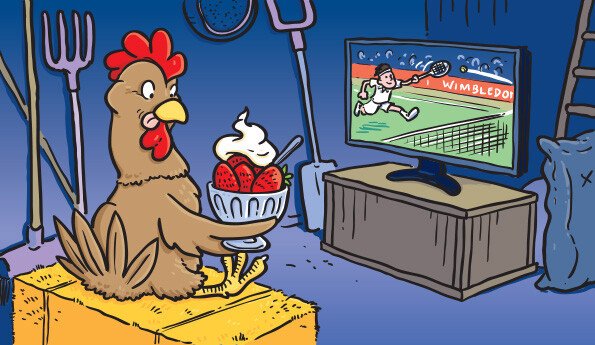
Choosing your Chickens
Choosing your Chickens
Where do you go to buy your chickens? There is not a shortage of people selling chickens, in fact as the demand increases so does the amount of suppliers. If you are a first-time buyer it’s best to source a supplier who is going to give you advice and back-up when you get the girls home. You will undoubtedly have lots of questions to ask prior to buying the girls, and if things go wrong you will need to discuss with the supplier before spending out on vets. Without doubt the best way to source a local supplier is to talk to neighbours or friends who have chickens, as they will soon tell you if their contacts are to be recommended or not. You will find adverts for breeders in local papers and websites, and there are auctions that you could attend as well as various markets. However, without doubt, I would strongly recommend using an established outlet that will spend the time to discuss the health and welfare of your new girls.
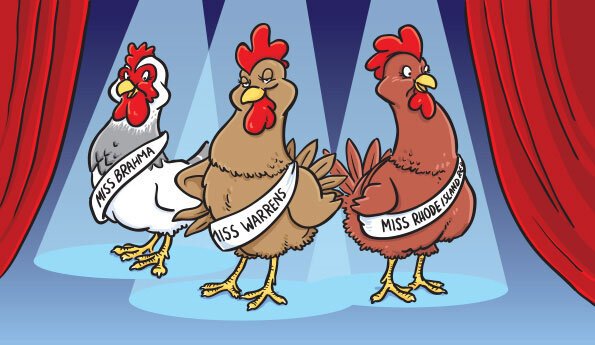
Which Breed?
Which Breed?
There are literally thousands and thousands of breeds to choose from; pedigree stock carrying designer price tags, glamorous-looking types, those laying green and blue eggs, even feathered leg varieties and the elegant hat-wearing types – you could fall in love with them all. Now let’s get back to reality: what do you want from the chicken? Admiration from the neighbours or a regular supply of eggs to feed the family? If it’s the egg supply then you will need to look at the hybrids. These are birds that were bred to simply produce eggs back in the 1950s when there was need to produce more eggs as cheaply as possible.
The Perfect Egg Laying Chicken?
Different strains of chickens were matched up together to find the perfect egg-laying bird, one that would lay over 300 good size eggs a year, not eat too much food, small enough to put into a cage with a few more, and most importantly very docile to avoid them fighting each other. Therefore this type of chicken comes with a guarantee of producing lots of eggs when given a loving home.
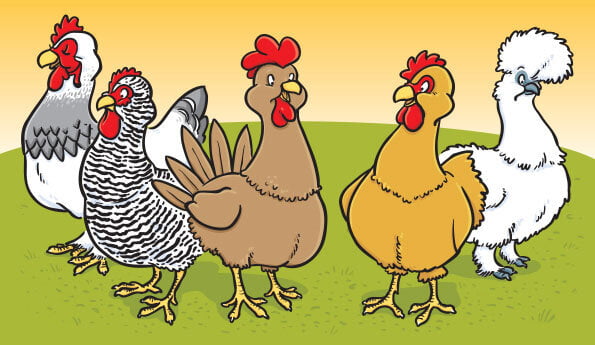
How much will the chickens cost?
How Much Will the Chickens Cost?
There is a very large difference in the price of chickens. Again, the hybrids should be the cheapest with the very fancy breeds carrying an expensive price tag. The chickens that we sell at Longdown Activity Farm are £12.50 each. They are hybrids – Warrens (Rhode Island Red normally crossed with Plymouth Rock). Sometimes the hybrids come with different fancy names but to be truthful all hybrids will provide you with a regular supply of eggs – but do not expect to get a Sunday roast from them when they have finished laying!
If you are looking for the fancy breed of bird then you will need to look for a specialist breeder; search engines are good for this.

What to ask when viewing chickens?
What to Ask when Viewing Chickens
You may be an expert or a novice, it really does not matter, but there are some things that you need to know when you purchase your new girls:

What breed are they?
You should be told exactly what breed they are. If you are buying traditional breeds it’s worth knowing who the original breeder was for future reference when choosing future breeding stock.
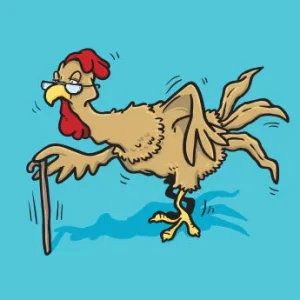
What age are they?
An ideal age to buy your chickens is 16 – 20 weeks. These are classified as Point of Lay; it does not guarantee that they will lay when you get them home – that will depend on many other factors. It is very unlikely that a chicken would have had all its vaccinations and been wormed if they are younger than 14 weeks.
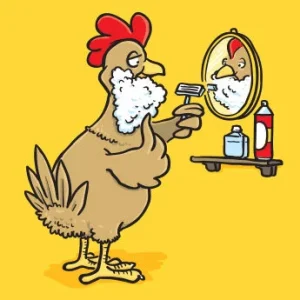
Are they guaranteed females?
Assuming that you are buying your chickens to lay eggs, then it would not make sense to buy a cockerel. It is no advantage having a boy amongst the girls, in fact it would cause more problems than it’s worth. Chickens will produce eggs quite happily without any boys being present; obviously they will not be fertile. The girls are normally friendlier without the presence of a male strutting about amongst them and no matter how nicely you speak to your young man he will still upset the neighbours at whichever time he chooses with his vocal outburst.
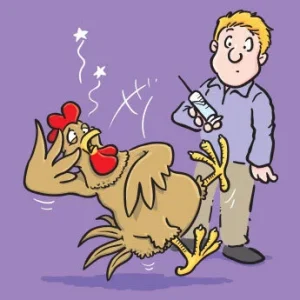
Have they been fully inoculated and if so do you have a list of what with?
All commercial poultry rearers vaccinate their stock with a large number of different vaccines; these can change depending on different geographical circumstances. Many smaller producers do not worry about vaccinating their stock, but personally I feel that it is better to be safe than sorry. Rearers normally are happy to give you a list of all vaccines that the girls have had.
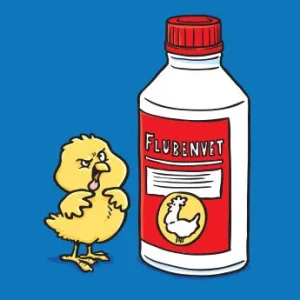
Have they been wormed and if so with what and when was the last wormer administered?
Most rearers will commence a worming programme when the girls are about 14 weeks old and treat them with a product called Flubenvet. There are others who will prefer not to worm them in case the new owners prefer to use an organic product, this a personal choice.
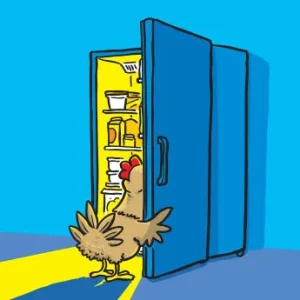
What are they being fed on now?
Moving a chicken to a new home can be very stressful for the poor girls, therefore to change their feed at the same time is adding to the problem, so it’s worth asking for a small bag of the feed to reduce this risk or simply make sure you have the same type in stock.
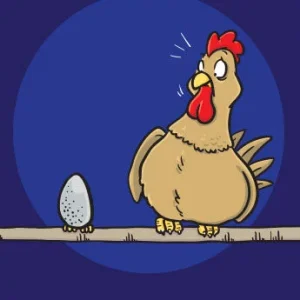
Are they housed in deep litter or are they trained on perches?
Many rearers keep their chickens on deep litter therefore the girls are not used to using the perches in their new house. It’s worth knowing this from the start as you then will know that you will need to lift some of them up onto the perches when it gets dark; this will help prevent them from sleeping in their nest boxes and spoiling the eggs.
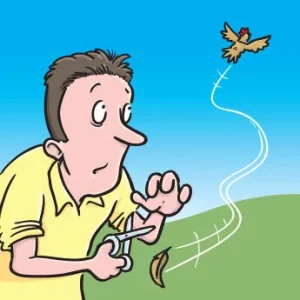
Have they had their wing clipped?
To prevent your chickens attempting to scale the neighbour’s fence it’s advisable to clip a wing. Don’t clip both wings otherwise they will soon regrow and off she will go. Most rearers will happily show you how this is done; it is one of those jobs that is easy when you know how. If you are not letting your girls out in the garden or would prefer to let the girls fly up into the trees then there is no need to clip the wings, but even if that is the case then it would be best to have been shown in case you need to do it later.

Do you get a warranty on your chickens?
Would you consider buying a car or electrical appliance without a warranty? Now chicken do not come with a three-year guarantee, however a reputable supplier should offer some form of assurance that if you have problems with your girls they will give you support. At Longdown Activity Farm all our livestock carry a 28-day warranty. If things go wrong for any health reason we will give support and advice, but we cannot take chickens back to re-home due to our strict movement regulations. Our after-sales advice continues throughout the chicken’s lifetime.
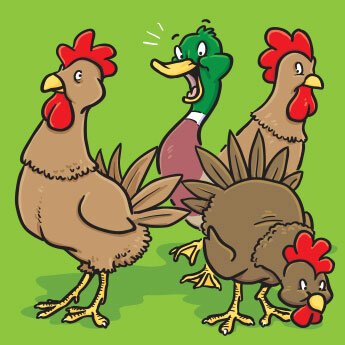
How do I tell if it’s healthy?
Are They Healthy?
Most rearers will let you choose your own chickens, therefore there are just a few things that you need to consider when viewing them. If you are not happy with the girls do not be afraid to say so, you do not want to take home problems!
Watch the chickens walking; they should walk with their head up high and their tail facing upwards or at least straight; if the tail is tucked down this indicates a digestive problem. When they walk they should raise their legs elegantly and be weight bearing on both feet.
The comb and wattle should be a pink or reddish colour depending on their age.
Do not be alarmed if the chickens do not want to be caught as this has probably happened before when they have been chased and injected. If you crouch down in their area they will come to you. Do not be tempted to go for the smallest or weakest as that will bring a costly veterinary bill with it.
With the young lady tucked firmly under your arm, check the nostrils are clean and free of mucus; the beak may be trimmed at the point (this is common practice for hybrid chickens). Listen to the breathing: if it sounds chesty or rattling, put it down; if you find another one similar, say goodbye to the rearer (politely), as this would be an indication that there is a respiratory problem on the premises.
Feel the legs; they should be fairly smooth. They will vary in colour. Check the feet; toes are sometimes disjointed but make sure that there is not a build-up of dirt on them.
Gently pull back the feathers to check for any little grey creepy crawlies or clutches of white eggs as this would indicate a parasite problem; the outer feathers should be glossy and shine.
Finally check the production end; the vent should be clean with soft fluffy down feathers around it; these should not be contaminated with any droppings.
If you are happy with your girls, head home as soon as possible.
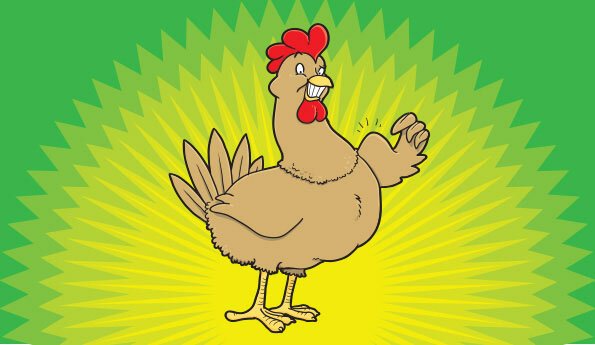
How do I get my chickens home?
How do I get my Chickens Home?
If you have arranged to view some chickens with the consideration of taking them home with you, then it would be advisable to be prepared and have a suitable box or carrier to take them home in, as you will not be able to sit them on your lap in the car on the way home.
If you have a plastic pet carrier (the type used to take a cat to the vet) that would be perfect, however it’s not cost effective to buy one for just one journey. There are many cardboard types on the market or, cheaper still, use a large cardboard box with plenty of holes (at least 25mm) cut near the top to allow the hot air to escape and give maximum air flow. It would be kinder for the girls and your passengers to drive with the windows open. Please do not stop on the way home to get supplies as a locked car will get hot extremely quickly.

What do I do when I get my Chickens Home?
What do I do when I get my Chickens Home?
The next 24 hours will be one of the most stressful times of your chicken’s life (unless it meets up with the local fox). Assuming that the coop is fully prepared and food and water is inside, then the girls can go straight inside. If the run is small then leave the pop hole open so they can have a look around. Please do not introduce them to the children or other pets on this first day as it can be a bit too much. A little Poultry Tonic in their water will help reduce the stress or even a very small piece of bread with Marmite on. Next morning they can be let out at the crack of dawn and enjoy their new surroundings. To keep your chickens friendly it’s worth picking them up and giving them a stroke every morning and evening for just 20 seconds each time during the first week. You will be amazed how they respond; after the first week they will be following you around like lambs!
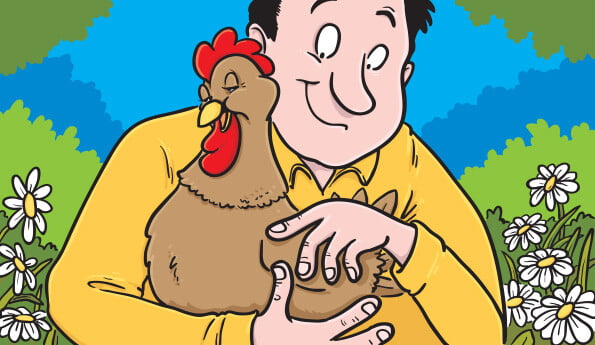
Why are they not laying?
Why aren’t my Chickens Laying?
Eggs do not simply appear, there are some factors to consider. The most important requirement is the correct dietary needs. If your girls are not laying for any reason simply remove all tit-bits and confine them to a small area for a few days, giving them access to only Layers pellets and making sure there is a fresh water supply nearby; this should then get them back on track to laying more eggs.
If the girls have had a fright from an attack by the neighbour’s dog or the local fox, this will put them off laying for up to 6 weeks. If you add Poultry Tonic to their water this will help to return the vital vitamins and minerals back into them. One thing to bear in mind is it’s not only you who enjoys eating the eggs that your chickens have laid and if you are not quick enough picking up those eggs in the morning, there could be something else waiting to steal them. Jackdaws, magpies, rodents and even the neighbour’s dogs are all queuing up to collect that egg in the morning if they can get into the nesting area, therefore if your girls have a red comb and her tail stands upwards you would be correct to think that she is in lay, so a quick look around the garden, under the hedges, behind the dustbin – even in the outside loo – would be recommended before changing her diet.
Of course, there may be an issue concerning the health or fitness of your chicken, more of which can be found in the Common Health Problems section.
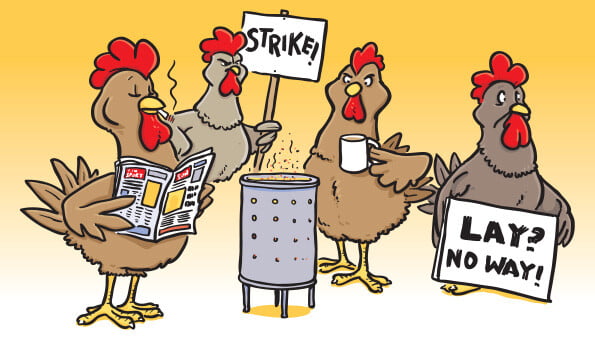
Predators
Chicken Predators
We all know that the fox is just waiting outside the gate each night in the hope that you forget to lock your girls away, but please remember that he is not the only creature after a dinner.
Dogs are the largest killers of poultry in domestic settings. I have more phone calls telling me that the neighbour’s dogs have just killed the pet chicken than anything else. It’s for that reason that the perimeter fencing should be secure.
Badgers are stronger than foxes; despite not being able to scale tall fences they are quite capable of using their powerful jaws to destroy any loose wire they can get their teeth into.
Birds of prey can be a problem in rural areas, but as long as your chickens have some form of cover on their runs this is not normally a problem unless you have small chicks on the ground.
Rooks, jackdaws and crows will also attack the smaller birds and they enjoy an uncooked omelette and seem to have a competition on how many eggs they can steal.
Rodents are attracted to any kind of poultry, however with good housekeeping these horrid things can be kept at bay. Making sure that your feed supply is stored in a suitable container and that scraps are removed from the chicken house floor each night will minimise the risk.
Secure housing and well-designed fencing will also reduce the risk of these predators savaging your pets. If you have an enclosed run, secure a sheet of weld mesh on to the base, laying it on to the grass; within weeks the grass will grow through, giving it strong support against the fox or any other animal trying to dig into the run, as they always try to dig at the edge and are not normally clever enough to think of digging 45cm away!
There are many suggested ideas on how to keep the fox away – hanging human hair in bags around the chicken house, leaving a flashing light near the coop, putting lion’s dung around the perimeter fences and even getting males to urinate alongside the house each night – but to be quite frank about the matter if a fox is hungry he will find some way to get into your chickens, so as long as you are happy with the security arrangements you have done your bit.
Persistent problems with a fox can only be solved by an expert shooter with a good rifle!
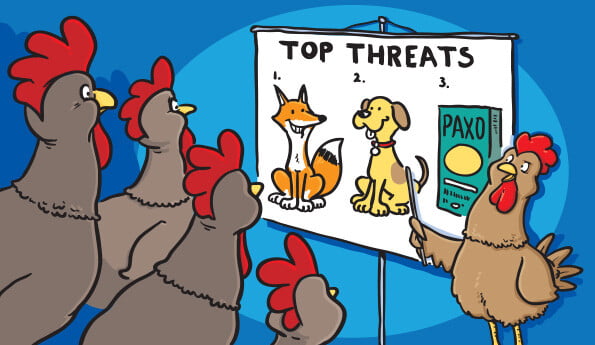
Common Chicken Health Problems
Common Chicken Health Problems
Chickens are fairly simple creatures and any health or behavioural concerns tend to fall into quite a small range. I have collected together the most common issues that you may encounter with some advice about how I would deal with the problems. Please remember that whilst I have years of practical experience looking after chickens, I am not a vet. If you have any major health concerns about your chickens, it is advisable to consult your local veterinary service.
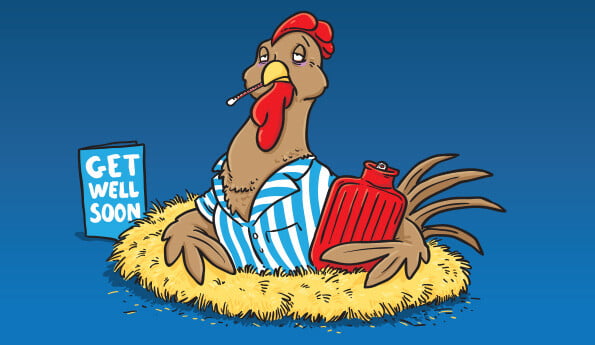
Moulting
Moulting
After continuously pumping out eggs for 15 months or so, the body naturally drains and needs recharging so they go into a moult. At this point chickens look as though they are going through a bad hair day with feathers falling out and looking lethargic. Depending on the time of year this moult can last up to eight weeks. The moult can happen at any time of the year, depending on when they were hatched. Losing your winter coat in January can come as quite a shock; when this happens the girls need a little TLC to help them pull through; encourage them to eat and add some Poultry Tonic into the water to help replenish the vitamins that have drained away during this process.
Whilst moulting, the calcium levels drain from the body, therefore egg production ceases or drops drastically, nature takes its own course and once the whole process has finished she will come back into lay again. It is vital that protein levels are kept high during a moult as the feather regrowth relies entirely on protein content. It is for this reason that this is one time that you can spoil your girls with a handful of mealworms each day, or change their diet to chick crumbs (not to be fed to laying birds, though).
Indications of a moult are the comb and wattles losing their reddish colour and turning very light pink, the feathers around the neck slowly dropping out, and you will notice her tugging away at the feathers, trying encourage the new feathers to come through. The long primary feathers on the wings are normally the first to fall out; she will become grumpy and possibly go off her food. Please bear in mind with all of this going on her entire body is very sore and tender so she really will not appreciate being picked up and cuddled!
Moulting is a natural process but it is worth remembering that it can also be brought on by stress or dehydration and, in some extreme cases, sudden weather changes.
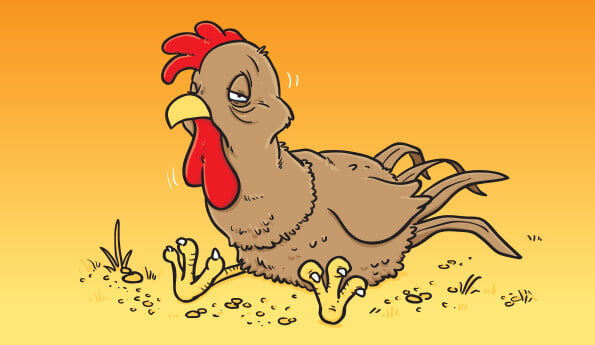
The dreaded red mite
Red Mite
I have more messages regarding red mite problems than anything else regarding chicken welfare and it is one of those situations where prevention is better than cure. Those people who purchase plastic coops do not seem to have so many problems, as the little creatures do not breed so fast. Red mites seem to come in from everywhere; they can lie dormant for years then suddenly reappear. Firstly it’s best to know if there is a problem in the coop, so check the girls on a regular basis by gently moving their feathers to see if you can see any grey (they remain grey until they have drawn blood from your girls) creepy crawlies scurrying through the down. If you see one or two you have a problem. Another way of detecting a problem is to wait until it is dark (red mites move more during the hours of darkness) and put your hand inside the nest box; hold it there for 30 seconds and you will soon know how it feels to be invaded by them, as they will crawl up your arm!
Laying double-sided sticky paper on the top of the house is also another indicator; I use sticky fly paper to do this job. If your chickens refuse to go to bed at night by just waiting at the door and refusing to go inside then there is a high possibility that there is a problem inside the house. Chickens that are lethargic and hunched should also be checked; eventually these little mites will suck so much out of the girls that they will die.
Prevention is without any doubt better and easier than cure. A few good housekeeping tasks will keep these little urchins away.
Clean out the hen house on a regular basis, keeping a beady eye out for any tell-tale signs of a red mite presence.
Keep any soiled bedding well away from the house otherwise they will soon be creeping back home again.
Check your chickens on a regular basis; this also keeps them friendly.
Scatter Diatom (dust) around the inside of the house weekly. This is an organic product (yes, some organic products really do work); as the mites crawl to attack their prey the dust cuts them, which eventually causes them to disintegrate.
Wash out the chicken house on a regular basis using a solution of Poultry Shield; this is the only product on the market that I know will melt the red mite eggs as well as killing off any live mites. All cracks and crevices should be sprayed as this is where they will be hiding. Make sure that you follow the suggested dilution rates otherwise you will find it will not be as effective.
Keep a regular watch on any bedding. Buying this in sealed bags reduces the risk of the little creatures breeding amongst it.
Dealing with an infestation is a heartbreaking task. You feel that you are not getting anywhere fast; you get to the stage that you read the forums and they tell you that the only cure is to burn the house down. Of course that is true but rather drastic. Perseverance is the main requirement. If you can give thought to the lifecycle of the mite, it is breeding on a daily basis and we are talking of literally thousands being hatched daily. No matter how clever you are you are not going to destroy these in one swoop. Allow yourself 14 days minimum but do not be surprised if it takes twice that long to eradicate these dreadful creatures.
Clean out the coop every other day for 10 days, spraying Poultry Shield into the roof space and any cracks on the sides and floor. Wash out the food and water bowls with Poultry Shield at the same time, paying particular attention to the nest box area. Ideally any spoilt bedding should be burnt or, if that is not possible, store it in plastic bags and take it to a council dump.
Spray the chickens at the same time. I have found that Poultry Shield is ideal for this, however it does not carry a veterinary licence so you do so at your own risk. Another good product is Lincoln Powder, or simply give the girls a good dusting with Diatom. Please watch their eyes and vents when using these products and do not forget to follow the Health and Safety guidelines for the user.
You will notice a reduction of activity in a few days then after 10 days there will be only a few stray ones. Do not stop the treatment at this point, simply go to once or twice a week then all of a sudden you will see your girls perk up and very few mites will be seen. Mites can appear at any time of the year but most activity will take place during hot and cold seasons.
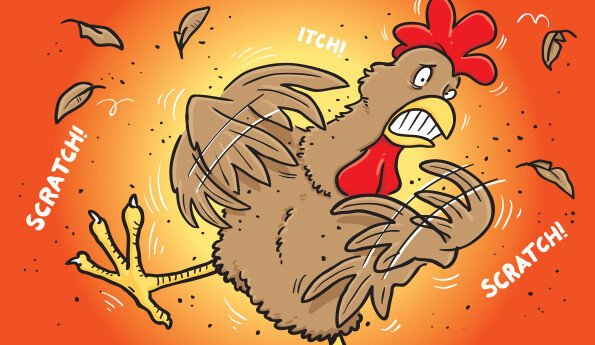
Egg eating
Egg Eating
This is one of those habits that infuriate the poultry keeper, and is a habit that is hard to break. I, for one, have tried so many ways of solving the problem. Once I even filled up a blown egg with my favourite brand of whiskey; to my sheer horror I found all the chickens liked the taste of it as they ran merrily around the paddock! Again, there are so many remedies to prevent the girls from eating their own eggs but I could not guarantee which ones will be the most effective. Filling up a blown egg with a very strong mustard mix probably gives the most amusing results, or a product called Stop Peck (I have found this one useful in stopping my granddaughter biting her nails and puppies chewing the furniture, however these are not official tips) sprayed on the outside of the egg. China eggs sometimes work; even plastic ones! But the most reliable method is to keep the nest box as dark as possible using a dark cloth across the front with a slit to allow access; this prevents the girls from seeing the eggs, in return not being tempted to peck at them.
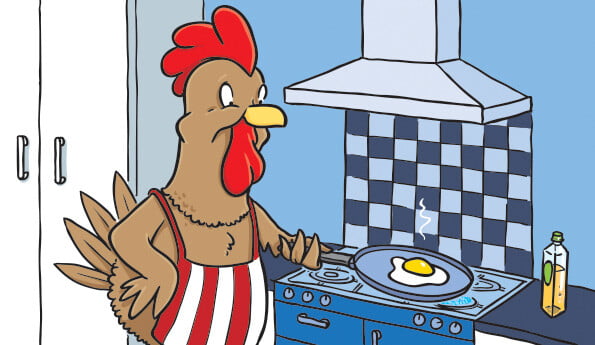
Egg abnormalities
Egg Abnormalities
Eggs naturally come in all shapes and sizes and a variety of colours as well; as long as the egg is not too large or soft your girls will pop them out quite happily. It’s when they start becoming too large or misshaped that problems occur. An early indication of this will be soft-shelled eggs, and ones which have calcium deposits on them. For years now the use of grit has been promoted to increase the bird’s ability to break down the feed as it goes through her digestive system. Unfortunately the hybrid girls have a smaller crop capacity and find that when they consume large amounts of grit it lodges in the gullet and sometimes can cause compacted crop. We have found the use of Shell Aid in the girls’ water periodically helps to maintain strong and healthy egg shells.
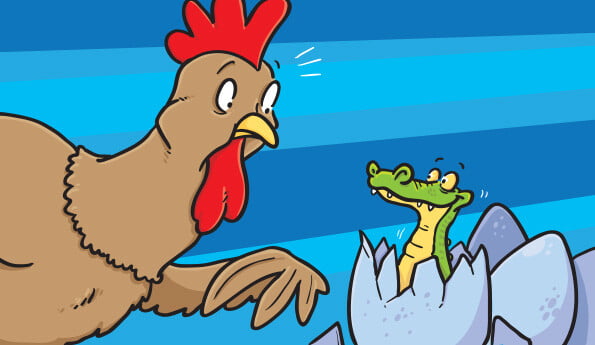
Prolapse
Prolapse
Prolapse in chickens is not a very pretty sight and it’s not very pleasant for the young lady either. This can be caused by too large an egg trying to be passed, and is most common before she goes into a moult, or as she gets older, and the muscles get weaker, soft shelled eggs are extremely difficult for them to pass and therefore the oviduct is stretched. Normally the oviduct retracts, however where it is strained with the forcing of the large or soft-shelled egg, the whole oviduct remains on the outside of the poor chicken, which is soon noticeable even to the novice keeper.
Prevention is simply making sure that your girls have a well-balanced diet with adequate calcium levels, and they have plenty of exercise and access to sunshine. This will help to keep the girls healthy enough to prevent it happening, however as long as your girls are laying there will be a small chance that they are going to have a prolapse, and without me sounding too much of a callous farmer, I would say that it’s less than a 50% chance that you will get the prolapse to stay back in. Some vets will stitch it back but once the chicken commences laying again it will more than likely pop out once again.
Treatment can be carried out by a novice as long as you are prepared to get your hands dirty!
Prepare yourself with plastic gloves, some Witch Hazel and some warm soapy water; you will need to remove your patient from the flock and have an area to put her into after you have treated her, otherwise the rest of the flock will peck at her. Wash the entire area with the soapy water, taking care not to damage the delicate tissue, making sure that the entire oviduct is clear of any droppings and damaged egg. Once you are satisfied that it is clean enough, gently dry the protruding parts and dab Witch Hazel all over, then with two fingers gently push the prolapse back in and hold there for 30 seconds or so. She will naturally try to resist so be prepared to see it pop out again within minutes. Repeat the process if this happens or seek veterinary assistance. If it stays in at this point keep her isolated from the rest of the flock, monitoring her on a regular basis. Do not put her back with the others until she has healed up completely. Please do not be tempted to strap her up to prevent the prolapse as this can cause the girls a great deal of discomfort.
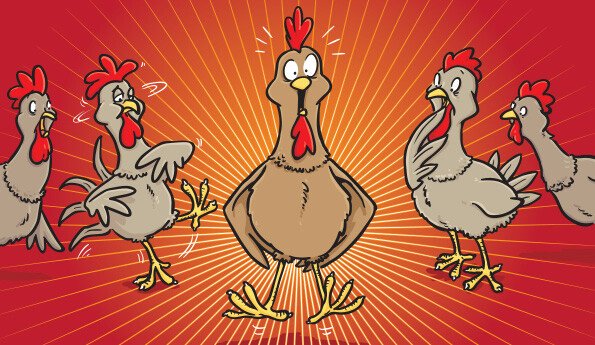
Eye problems
Chicken Eye Problems
Eye problems are quite common with chickens, which is not surprising when you consider where their heads are half of their lives, facing downwards with dust and all sorts flying in all directions. Despite the eyelids moving upwards she is bound to catch a few flying objects in the eye. When this happens there is a chance of scratches within the eye housing; a warm teabag applied on this twice a day normally helps to relieve this, or if the problem persists then an eye balm (make sure it’s a veterinary one) will sort out the problem. If the eye is weeping and there is a discharge from the nostril we are looking at a different problem. This could be the start of a cold or even pneumonia. If you find more than one chicken with these symptoms, then you will require some assistance; if you look through the website forums, please be careful not to get too carried away with what you read, otherwise a common cold could turn into Avian Flu. It’s always best to seek the advice of people who deal with poultry on a regular basis, preferably the person that you purchased them from.

Respiratory problems
Respiratory Problems
Respiratory diseases identified in early stages will not be a problem, it is when they are not treated that they become fatal. Just a quick look at the girls’ nostrils each morning will soon tell you if your girls are unwell. Sometimes a grass seed can cause them to have a sneezing fit; this can go on for several days. A damp piece of cotton wool wiped across the nostril on each side will normally dislodge any foreign bodies hiding there. If she is lethargic and has a bubbly type mucus forming at the nostrils and her eyes are swollen with bubbles forming, there is something more sinister going on, most likely mycoplasma. If you hold her close to your ear and listen to her breathing, and it sounds rattly (like someone who smokes 30 cigarettes a day) she needs to be treated. Antibiotics do not kill viruses, however they will sort out bacterial infections, which are normally brought on as a secondary infection. The choice is yours: you could take her to a vet to seek advice or increase her vitamin levels by introducing Poultry Tonic into their water (it is best to treat all the girls at this stage). There could be various problems at this stage; please do not worry yourself by looking up all the different viruses with long names; in the domestic flock it’s best to seek your veterinary surgeon’s advice; this is when you need the list of vaccines that you requested when you purchased them.

Scaly Legs
Scaly Legs
Scaly legs is where small mites burrow into the girls’ legs, forcing the scales to rise which in turn – as they dry out – become crusty. It is very irritable for the girls, as you can imagine. The old-fashioned way of treating this is to stand the girls in a jar of surgical spirit at least once a week, but this will take months to get rid of them. I find a product called Scaly Leg sprayed on their legs on a regular basis seems just as efficient, and not so brutal.
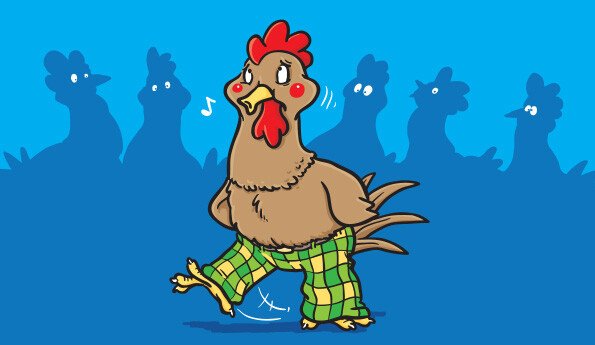
Cramp
Cramp
Cramp is not uncommon in chickens. It is more common in damp conditions and the birds will struggle to walk, if you soak their leg in very warm water two or three times a day, stretching the leg as much as possible, you will normally sort the problem out within a few days.
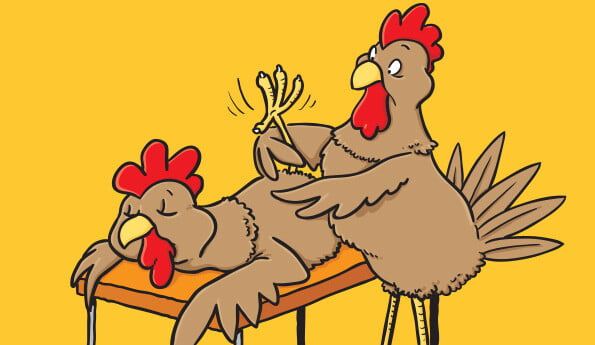
Worms
Worms
Worms are present in most poultry, however they are not always a problem and they can live together in perfect harmony. Well that is until your chicken gets stressed, then that is when the worms can take over. There are many types of worms working inside the girl’s digestive system, some can even take over inside the respiratory system. The common sign of an affected bird is white droppings sticking to the down feathers around the vent. I personally would not sell a bird unless it had been wormed with Flubenvet as I know the risk of sending a chicken to a new home, maybe mixing with other chickens, can cause major problems. On the other hand, if I only had two or three chickens producing eggs for us to eat, then personally I would be reluctant to use an “active wormer”. Of course if the chickens were showing symptoms of a worm infestation then they would be dosed immediately. My choice of action would be to add Diatom into the girls’ feed on a regular basis; this will certainly help to keep the worm levels down – it definitely will not eliminate them but I would be happier eating the eggs. Using a clove of garlic in the water not only helps to build up a strong immune system, it also reduces the worm population in the chicken. That’s one that I learnt from my mother many years ago, and it’s still just as effective and you will not get garlic tasting eggs for breakfast!

Egg Peritonitis
Egg Peritonitis
Egg peritonitis is a problem found in chickens where they lay unformed eggs and the yolk drops off into the digestive tract. Sometimes this can be absorbed, however if this problem persists then you will find your girl walking like a penguin and have a expanded undercarriage. Again, this is a time when you need to consider her welfare and take her to a vet or decide it would it be kinder to put her down.

Compacted crop
Compacted Crop
Compacted crop can cause a great deal of discomfort to your girls. It normally affects the greedy ones amongst them as they dive into the feed as if they have never been fed before. The crop only allows a certain amount of food through at a time, allowing time for the enzymes to work. Usually, as they sleep the food gradually filters through, so if she still has full crop in the morning that is the first indication of a problem brewing. For them it’s a form of indigestion. Olive oil is still the best form of treatment for this problem. If you feel that your chicken is suffering with a compacted crop simply offer her some olive oil from a small jar and this will help dislodge the blockage. If she doesn’t take this on her own, then syringe some down her throat, very slowly through the side of the beak, three or four times a day. An alternative remedy, if you are not squeamish and the patient is still eating, is to offer her some white maggots (must be white). These are available from a fishing shop or online. These little creatures will take 4 days or so to eat their way through the debris in the crop. If the blockage is not cleared in a few days this will then lead to a sour crop, which emits an awful smell when you open the chicken’s beak. This demands urgent and drastic action, tipping the girl downwards and keeping her beak well away from you, then massaging the crop until fluid comes out. Please only do this for a maximum of 20 seconds as the poor girl cannot breathe efficiently whist doing this. This will need to be done at least four times a day before any results are seen, and bear in mind that you are only trying to remove the fluid from her and not the solids otherwise choking can prove fatal. If this fails then it’s a trip to your veterinary surgeon who will be able to lance the crop, which, despite being very expensive, is not always successful.
The best ways of preventing compacted crop from happening in the first place is not to use hay in the nest boxes as they tend to try to eat this (barley straw is fine), reduce access to grass areas in the spring as they gouge themselves on this, keep the feeders off the ground so they have to stretch their necks when eating their food, and make sure that there is adequate water near to their feeder as this aids digestion.
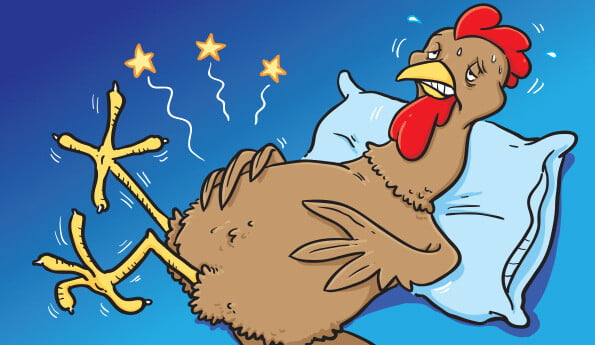
Feather pecking
Feather Pecking
Feather pecking is quite common when introducing new girls mainly because they are territorial creatures and there will always be a pecking order in the poultry world. They sometimes will fight to the death and if that’s not bad enough they will continue to eat the poor victim when they have killed it. This is not a pretty sight at all especially for children to see. Sometimes your older girls will set on each other for no apparent reason, after living in harmony for years. This can be brought on by several different reasons: boredom, dietary changes or simply a fall out within the flock. Very often a moult is mistaken for a pecking problem, so it’s important that a close examination of the feathers is carried out before telling your girls off. You will notice broken feathers under the larger remaining ones; these are normally surrounded by peck marks around the skin. If the problem is obvious, and you witness it happening, it is most likely the bird with the largest comb who is the bully. The quickest and most effective way of dealing with it is to find a powerful hosepipe and hide behind the coop and when the offending bird picks on its prey, give it a quick, short blast behind the head. The trick is not to let it know it’s you behind the hosepipe; she needs to believe that the victim has a friend up in the sky! Please do not allow children to take this role on otherwise you will have drowned chickens. I admit it does sound cruel but certainly not as cruel as being pecked to death. If the birds are losing feathers and flesh is showing it’s best to shake some talcum powder or mite powder over them to give them all a neutral smell. A product called Stop Peck can be a deterrent for the most persistent offender. If blood is drawn an ultra violet antiseptic spray should be put on the wound as it will help the healing process and cover up any signs of blood. As a rule of thumb, if the victim is being pecked at the top of the head or if she is bleeding then she should be removed or better still if you know who the bully is put that one into confinement.
You might read that putting vinegar in their water will stop pecking if it’s a dietary problem, but it would make much more sense to put in a vitamin balancer like Poultry Tonic, which is processed to supply the chicken with all the vitamins required.
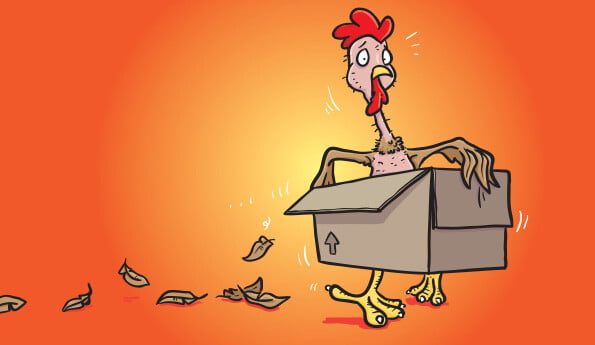
What do I do when my chicken is ill?
What do I do when my Chicken is ill?
Like any pet there will be a day when your girls become ill and you need some advice. The first answer is to pick up the phone or email the person who supplied your girls to you. Not all poultry sellers offer a back-up service and some only offer a limited warranty on the birds, but it is always worth trying in the first instance. At Longdown Activity Farm we pride ourselves for giving unlimited advice to people who have purchased their girls from us, and we happy to discuss problems with other poultry keepers. We are not vets but have years of practical experience in looking after chickens. If the illness is severe we will recommend a veterinary practice close to you who may be able to assist.

Chickens do not live forever
Chickens Don’t Live Forever . . .
Unfortunately chickens will not go on forever and will eventually die, or harder still will need to be put down at the end of their lives (most hybrids will live 4-5 years). As most domestic keepers become very attached to their girls it is very difficult when a decision has to be made to put her down. Now some people will not have a problem with putting their pet to sleep but remember, at least it will no longer be suffering. It would be worth a phone call to your supplier or veterinary surgeon or, if you know someone who keeps ferrets they may be happy to help. As the law stands it is illegal for your chicken to be buried on your premises as poultry do not come under the pet exemption category, therefore it is suggested that you take your chicken’s body to a veterinary surgeon or somewhere else registered to dispose of animal carcases. If you decide to bury your girl in the garden please bury it in a deep hole (1.2m) and cover it with lime or a strong disinfectant to avoid foxes and badgers digging it up.
It’s always worth contacting your local Trading Standards office as it’s their responsibility to govern the disposal of livestock.
